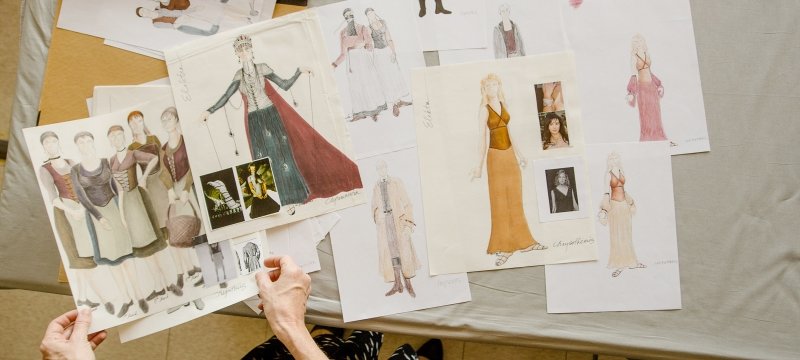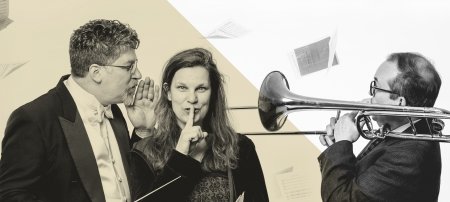Step behind the curtain for a peek at theatrical mastery with Michigan Tech costume designer Mary Cyr and her students—and some hints at what the Department of Visual and Performing Arts (VPA) has planned this season.
Mary Cyr rolls a costume rack along the familiar-to-her path from the light-filled second floor of Walker Arts and Humanities Center down into the dark, cool underbelly of Michigan Tech’s Rozsa Center for the Performing Arts. The cart balks entering the elevator (and resists straight-line navigation in general). Cyr, unrattled, pauses under the orchestra pit. “They tend to veer,” she says, “But I’m pretty good at driving a rack.”
During VPA's busy production season, Cyr doesn’t roll solo in the Rozsa tunnel—a host of Huskies join her, schlepping from the dressing rooms to wardrobe stock and back again, putting on large-scale projects in fall and spring, as well as smaller productions. VPA faculty decide together on the schedule, then work side by side with students and staff on every element of the process. The ability to learn the ropes in multiple facets of theater is a program quality students mention time and again.
Costume design itself contains multiple elements, including hair, makeup, and accessories.
“It’s not just the clothes on your body. Here, we do it all,” says Cyr, who hires costume shop assistants every year to help keep up with the constant process of acquiring, altering, culling, making, pulling, replacing, and organizing.
Calling the Show, Calling the Shots
“I've stage managed almost every show I worked on since I was in 10th grade. It's a process I really enjoy because I get to combine my logical and management-oriented brain as well as my creative and artistic side while I'm in the rehearsal room with a director and the actors,” says Madi Wentela. The 2021 VPA All Arts Award winner has been involved in theater since seventh grade. “Tech got on my radar as I was looking into colleges because my extended family is from the UP. I spent pretty much every childhood summer in the Houghton-L'Anse area growing up, so the UP was really familiar and comfortable for me,” she says. Another major selling point: Wentela's sister Makenzi is a 2020 theatre and entertainment technology graduate. “I knew I was going into a good program,” Wentela says. “The things she emphasized (and the things that I'm enjoying most now) are related to student leadership.”
The do-it-all practicum of MTU VPA drew current costume shop assistant Madi Wentela to the program. The junior theatre and entertainment technology major is fascinated by the earliest stages of production. “My favorite part of the process is the initial design phase, especially when designers (costume, set, lighting, sounds, etc.) come together,” says Wentela, whose emphases are on management and costuming, with a minor in art. “Often the initial designs are wildly different from each other before an overall vision is decided on. It’s so interesting to see how different people interpret the same script.”
The designers arrive at their initial design in different ways. Cyr's process begins with in-depth research and inspiration accumulation. "I'm a bulletin board person," says Cyr, who translates her concepts into sketches in whatever medium is at hand and best suits her mood and the project: watercolor, colored pencil, pastel, marker, gouache—and digital. Like many designers across disciplines, she collects and curates on Pinterest. Cyr also loves playing with new programs—some student-suggested—to digitize her designs. “Every year I learn so much from students,” she says. “They help keep me current.”
For Cyr, renderings are one of the most enjoyable aspects of costume design. Time and place. Details about individual characters, groups, and their relationships. Costume design works with all the other design elements of a production to support the director’s vision—and wow audiences. American costume designer Edith Head, the most awarded woman in Film Academy history, called it “a cross between magic and camouflage.”
If you’ve ever been backstage at a theater, you understand how magic and camouflage come together in these spaces. Even in the late-summer quiet, the atmosphere backstage at the Rozsa is charged with the work that has happened and the work to come. You feel it in the costume stock room, where choir robes and wool coats await their next turn under the lights, and in the austere rows of basic black shoes, bins of tights and ties, endlessly alterable suits, purse racks, and a rainbow of bell-skirted day dresses. (“When we did West Side Story, I basically pulled most of that show (from stock),” says Cyr. “I did build all of the lead costumes.”) Expectation is palpable, from the pattern drawers to the dressing rooms—and all the way up to the second-floor costume shop, where new pieces are conceived and constructed and many a Husky makes their first stitches.
Sewing (and Sowing) Sustainability
One such Husky is Sarah Jo Martens ’18 ’19, who started with a basic sewing course. Martens, an environmental engineer, incorporates sustainability into her continuing love for theatre (her minor at MTU) and costume design by incorporating cast-off fabric and upcycling into her process, chronicled in her blog, Second Life Stitching. “I very rarely make a pattern twice. How would I learn anything new from that?” Martens writes.
The Michigan Tech Theatre Company member appeared in nine productions and worked behind the scenes in a myriad of capacities, including assistant directing and voice acting. She worked five months in the costume shop.
"The two biggest factors in my choice of Tech were the engineering and VPA departments. The fact that I could combine both was essential for my life and education. The combination has enhanced my engineering degree with soft skills like public speaking, creative thinking, and empathy that are essential for my career now."
Taking an elective sewing course was a leap. “I was nervous to start because the folks who were involved in costuming with the theatre program were so darn good at it,” Martens says. “The perfectionist in me was scared that I wouldn't be able to catch up, no matter how fascinated and inspired I was. In pushing past that doubt, I gained a unique skill set and a mentor.”

The Goose Girl
See Sarah Jo Martens’ entry in the Foundations Revealed 2021 competition. Her design interprets Princess Anidori-Kiladra Talianna Isilee of Shannon Hale’s The Goose Girl. Video Credit: Michigan Tech alumnus Taran Schatz
Sew What?
Costume shops don’t normally have waterway views—and “shop” is a misnomer for all that takes place here. An ideal size for eight Huskies sewing or six working on theater crafts, the shop is part lab, studio, and makerspace. Like its campus counterparts in other disciplines, it’s open for use outside of class—students in the introductory sewing class can also check out sewing machines. Here, students play with material, proportion, and process. They research, pattern, prototype, and construct, emerging prepared to gain a foothold in a notoriously challenging profession. For example, after MTU's basic sewing class, students are qualified to be a stitcher with a summer touring company or another venue.
"Students leave here highly skilled. We create adept technicians who can go out and get jobs in theaters. We want people to say—and many already do—‘We want to hire Michigan Tech students.’"
Sketches are beautiful and necessary, but useless if they can’t be built. Fabric is the true medium of costume design. How does it feel? How does it drape? How will it move? Can the material make a skirt spin “like a poppy” (as Cyr was once complimented)? It’s a fallacy, she says, that period costumes are the most daunting genre to do well. It’s a lesson Cyr learned as an MFA student, champing at the bit to construct more elaborate pieces.
“Designing modern clothes with meaning is the real challenge,” she says.
So is the ability to be quick and agile, like making four shirts in two hours for the lead actors in MTU’s February 2021 production of The Complete Works of William Shakespeare Abridged [Revised]. “They were simple shirts,” she says matter-of-factly. Cyr starts her students out simply as well, assigning a piece—like a shirt—that she knows will be wearable and useful.
The costume shop is a favorite spot for theatre and entertainment technology major (and prospective shop assistant) Brie Stampfler, who is beginning her second year at MTU.
“I hope to learn a lot more about all of the design and staging processes this coming year, but so far my favorite part is and probably always will be the sewing aspect,” says Stampfler. “I love the process of taking 2D pieces of material and making them into a 3D shape that is wearable.”

Like a Project Runway season, students in costume design experiment with different techniques—and in true Tim Gunn style, learn to make it work. They create and dye their own fabrics, design and print a fabric pattern, transform found objects into wearable pieces, and experiment with leatherwork and jewelry. But costume design is not fashion. Beyond seams, fabric, fit, proportion, and silhouette, costumes have to stand the test of time and sweat, flex to fit a variety of sizes and body shapes, and look good from every seat in the house—and make fantasy believable. In a corner of the shop, next to a trio of mannequins sporting splash-dyed white scarves, is a case in point: the wearable armor prototypes students are developing for the big 2022 spring production of She Kills Monsters.
VPA students—and the students of any major who are welcome to be part of campus productions—are especially pumped about She Kills Monsters. Why wouldn’t they be? The 2011 drama-comedy loosely incorporates elements of the role-playing fantasy game Dungeons & Dragons, fondly known as D&D and regarded as a game for nerds (a label many Huskies embrace).
"The idea that sewing and costume design could be an actual career path for me thrills me to no end, as I come from a STEM family that focuses on math and science."
Cyr and her husband, fellow VPA faculty member Kent Cyr, have been working with students on elements of the production over the past year. Kent, who teaches stagecraft, focused on designing and constructing prop weapons. As part of She Kills Monsters show research, he taught students how to play D&D. “He felt it was important for them to understand the world we are trying to create,” Cyr says.
Living in a Material World
No VPA tour is complete without a glimpse of the spaces in and surrounding MTU’s multifunctional black-box McArdle Theatre, including a dye-wash and laundry room tucked behind the stage. “I did laundry by flashlight once so the crew could check their light levels from the booths backstage,” Cyr says.
For Wentela, the dressing room adjacent to the McArdle epitomizes the ever-changing nature of live performance. “It’s so multipurpose,” she says. “It’s used to teach the makeup design class, to work on sewing small projects, to conduct fittings, or as a prep space for actors on show nights—and so many more uses. It's a really special place to me.”
For Martens, most every corner of VPA is alive with memories. She found serenity among the wardrobe racks.
"I credit Mary for giving me the tools and encouragement to embrace sewing as a passion. I would've never taken up the needle without her classroom and life lessons as a mentor and friend."
“If I needed a break from everything to just breathe and do a task, then (I went to) costume stock, since there is no Wi-Fi and nearly no cell service down there, and really no one to disturb you,” she says.
Stock might seem like an odd name for a wonderland of fabric, color, silhouettes, and symmetry—it feels anything but standard! But, the meticulous organization and variety are plain to see.
“Amazing, absolutely amazing! Anytime we needed something, it was probably there, or something we could quickly modify to make it what we needed. I remember the first time going down and being blown away by the amount and range of STUFF there,” says Martens. “Once I started pulling items for productions, I would find pieces I had worn and be suddenly back in the shoes of that character. Those costumes are like sensory memories to me. Every time I'd stumble upon one, it would be a joy to think back on proud moments from those shows. It made me realize that (likely) every piece in stock has been designed, crafted, or worn by past students and community. I realized the longevity of the program and how many productions and people have been a part of it.”
Back to Live Performances (and Courses)
Now is the getting-ready time for a new season of productions. Some developments that make 2021-22 especially exciting: There’s a new director on board and a hush-hush special feature coming for the high-tech haunting that VPA conjures for the Copper Country every Halloween.
Like her students, Cyr relishes a return to live stage performances. She’s proud of the virtual feats students, faculty, and staff pulled off during last year’s production season. The department more than got through the global pandemic—revamped learning strategies and production techniques helped create an arts and entertainment lifeline for appreciative audiences.

But a less novel approach to her work comes as a relief—and beats the heck out of pandemic projects like creating a custom MTU COVID-19 face covering for Blizzard T. Husky. The task proved to be more challenging than you might expect because MTU’s mascot sees out of his mouth. (“I had Blizzard’s head at my house for a while,” says Cyr. “My 9-year-old had questions.”)
Stampfler looks forward to the shift to a genuine live theatre experience—and the opportunity to continue advancing in her field.
“This year I’m most looking forward to learning everything about the design process and how to get costumes from paper into clothing pieces,” she says. “Everything that I have done so far for class has been from pattern pieces and I’m excited to learn how to drape and alter.”
Wentela is ready to take on the roles coming her way.
“As someone going into stage management who will (hopefully) be completely in charge of running productions professionally after graduation, I really value the chance to have hands-on leadership experience and run a show as similarly as I will be in the professional world before I graduate,” she says. “The same goes for the jobs I hold on campus, working in the costume shop and the Rozsa galleries. They give me a taste of what professional life could look like after school ends and help me focus on what I really want to learn, as well as gain resume-building experience on campus.”
The stage is set. Cue a new season of sketches, swatches, sorcery, and stagecraft, soon to make its mark in both new designs and lasting memories.
Michigan Technological University is an R1 public research university founded in 1885 in Houghton, and is home to nearly 7,500 students from more than 60 countries around the world. Consistently ranked among the best universities in the country for return on investment, Michigan's flagship technological university offers more than 120 undergraduate and graduate degree programs in science and technology, engineering, computing, forestry, business, health professions, humanities, mathematics, social sciences, and the arts. The rural campus is situated just miles from Lake Superior in Michigan's Upper Peninsula, offering year-round opportunities for outdoor adventure.









